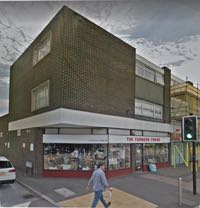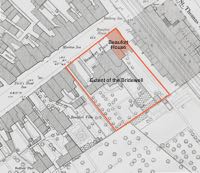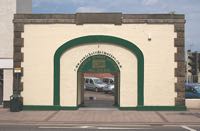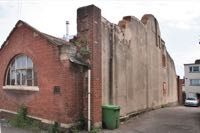
Prisons in St Thomas
The St Thomas Bridewell and the St Thomas Debtors Prison
Page updated 23rd March 2018
Return to Public Services
St Thomas Bridewell
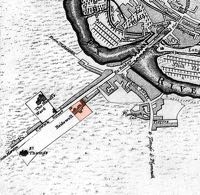 In the 17th and first half of the 18th century
there were two prisons
in St Thomas. Both a Bridewell and a gaol for debtors was located in Cowick Street. The Bridewell was situated in Beaufort House, formerly the seat of of the Duke of Exeter, John
Holland. The house dated from the 14th century. In 1637, it was converted into
the St Thomas Bridewell. Ten years later, during the Civil War, it was taken over by
Royalist troops during the siege of Exeter, and converted into Hunkses
Fort, where a garrison of men protected the west side of Exeter and the approach to the Exe Bridge from Parliamentary forces.
In the 17th and first half of the 18th century
there were two prisons
in St Thomas. Both a Bridewell and a gaol for debtors was located in Cowick Street. The Bridewell was situated in Beaufort House, formerly the seat of of the Duke of Exeter, John
Holland. The house dated from the 14th century. In 1637, it was converted into
the St Thomas Bridewell. Ten years later, during the Civil War, it was taken over by
Royalist troops during the siege of Exeter, and converted into Hunkses
Fort, where a garrison of men protected the west side of Exeter and the approach to the Exe Bridge from Parliamentary forces.
It returned to being a house of correction after the war and was used to house some 1,300 French and American prisoners during 1770. The building was demolished in 1809 and a new structure, also named Beaufort House, was constructed. It remained until the mass demolition of St Thomas in the early 1960's and the Farmers Friend occupied the site.
The Devon County Prison for Debtors
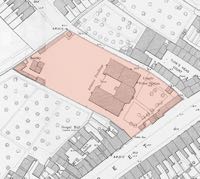 The front façade of Cowick Street Motors in
Cowick Street is all that remains of the entrance to the Sheriff's
Ward, the Devon County Prison for Debtors. The first prison on the site, which
stood from 1675 or earlier, became notorious as the ‘most feeble and insecure prison in
the Kingdom’. When a debtor entered through the front gate, he (or she) would have been taken to the Keeper's or the Common side, depending upon their place in society. The poor would be imprisoned in the Common's side, and the (previously) wealthy the Keeper's side. Despite being impoverished through debt, those in the Keeper's side would have been treated better and have financial help from friends, to pay the warders for better food and bedding. The poor on Common side would have had a truly miserable time, sleeping in rat infested squalor, and scraps of food.
The front façade of Cowick Street Motors in
Cowick Street is all that remains of the entrance to the Sheriff's
Ward, the Devon County Prison for Debtors. The first prison on the site, which
stood from 1675 or earlier, became notorious as the ‘most feeble and insecure prison in
the Kingdom’. When a debtor entered through the front gate, he (or she) would have been taken to the Keeper's or the Common side, depending upon their place in society. The poor would be imprisoned in the Common's side, and the (previously) wealthy the Keeper's side. Despite being impoverished through debt, those in the Keeper's side would have been treated better and have financial help from friends, to pay the warders for better food and bedding. The poor on Common side would have had a truly miserable time, sleeping in rat infested squalor, and scraps of food.
Paradoxically, even though they were all there for debt they had to pay an entrance fee and fees for essentials such as food and bedding. The schedule of fees in 1675 was:
| For the commitment of every prisoner | 13s 4d |
| Chamber rent | 2s |
| For finding lodgings | 2s 6d |
| Pay to be let out | 2s |
| Turnkey's fees 1s |
If a prisoner on the Keeper's side wanted a bed to themselves, there was of course a fee. If a debtor had no money for the fees they would placed in the Free Ward in the Strong Room. There was a fireplace, a small window, and barrack style bedstead, but for bedding or even straw.
The new prison
It was decided that it had to go by October 1817 and demolition commenced, to be followed the next year by the construction of a new prison at a cost of £8,000.
The prison opened in November 1819. Prisoners were not supplied with food, and according to one source, many died of starvation. An article in 1843 in the Western Times commented on the age and state of the prisoners.
"There are at present in the Debtors' Prison, St. Thomas Ward, Exeter, five prisoners, whose combined ages are 380 years, averaging 76 years each. Four of these prisoners are there under the most distressing circumstances, having but their prison pay for their support; and when they have paid for their bed, washing, etc. they are but 3½d. for their maintenance."
By the middle of the century, new ideas on prison design and reform brought about its demise. The last prisoners were moved to the County Gaol in January 1855 and the facility was closed, and sold to the Justice of the Peace of the County of Devon for £2,400. It became a barracks for the First Devon Militia. In 1892, it changed use again and was converted into artisans dwellings. All but one wing and the façade were demolished in 1909, with the remaining wing remaining as dwellings, and on part of the site was constructed a Wesleyan Church. The church is now John Holts carpet and furniture showroom. The old sandstone wing was demolished around about 1970 and in 1983, J Wippell and Co Ltd moved into a purpose built headquarters on the rear of the site with the front occupied by Cowick Street Motors.
Source - Cowick Street Conservation Area Appraisal and Management Plan. Local newspapers in the British Newspaper Archive. A History of the Devon County Prison for Debtors in St Thomas by Gary Calland.
St Thomas Bridewell
The Devon County Prison for Debtors
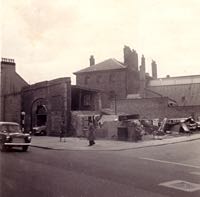
The site of the Debtors Prison in the 1950s. Although it looks like a bomb site, it was a used car business.
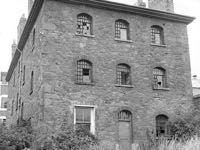
A view of the one remaining wing of the St Thomas Debtors Prison in Cowick Street, at the rear of Cowick Street Motors, before demolition circa 1970.
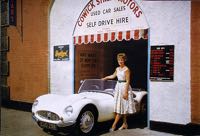
The St Thomas Debtors Prison in Cowick Street is now Cowick Street Motors.
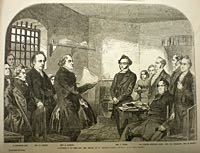
The Rev. Shore is visited during his incarceration at St Thomas' gaol (Devon County Gaol for Debtors) when he was imprisoned for not paying the costs of his case. Bishop Philpotts had him prosecuted for taking oaths to become a dissenting minister while already ordained a priest of the Church Thomas Latimer
│ Top of Page │
